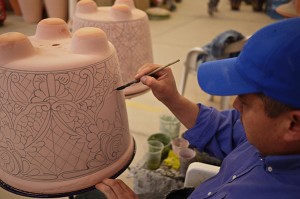 In the 2000s, seventeen workshops were producing Talavera in the old tradition. Eight were in the process of becoming certified. These workshops employed about 250 workers and exported their wares to the United States, Canada, South America and Europe.
In the 2000s, seventeen workshops were producing Talavera in the old tradition. Eight were in the process of becoming certified. These workshops employed about 250 workers and exported their wares to the United States, Canada, South America and Europe.
Although the Spaniards introduced this type of pottery, ironically the term Talavera is used much more in Mexico than in Talavera de la Reina, Spain, its namesake. In 1997, the Denominación de Origin de la Talavera was established to regulate what pieces could be officially called Talavera. Requisites included the city of production, the clay that was used, and the manufacturing methods. These pieces now carry holograms. One of the reasons the federal law was passed was that the remaining Talavera workshops had maintained the high quality and crafting process from the early colonial period, and the goal was to protect the tradition.
However, the tradition still struggles. Angelica Moreno, owner of Talavera de la Reina, is concerned that the tradition of the craft is waning, despite her workshop’s efforts. One problem the craft faces is the lack of young people who are interested in learning it. An artisan earns about 700 to 800 pesos a week, which is not enough to meet expenses.
